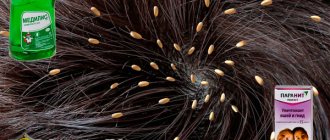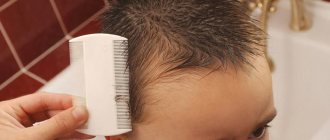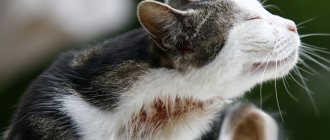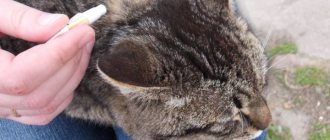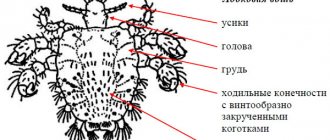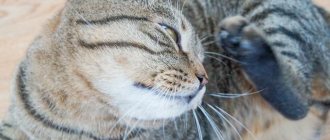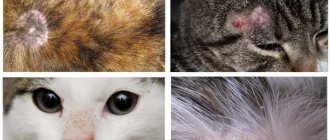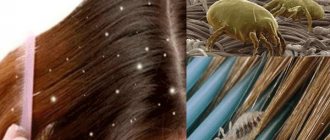A louse is a specific human parasite that feeds on human blood and does not live on anyone else. People cannot become infected with these insects from cats or dogs. But domestic animals also have parasites, which are called lice because of their similarity to the human head louse in appearance and lifestyle.
Lice in cats are called lice eaters. These insects attack the fur and skin of cats and cause a lot of pain. They differ from fleas: they cannot jump and are generally inactive. They live only on cats; if they get on other animals or humans, they die. Likewise, human lice do not live on cats.
Characteristics of the parasite
So do cats have lice and what are they? Cat louse is actually a lice eater and causes a disease called trichodectosis.
Many people believe that lice are a thing only for humans. But the reality is completely different, and even a mustachioed pet can get these pests. Cat lice are very passive parasites. Once settled on a tailed animal, they do not look for another owner. Their entire further development cycle occurs on one animal.
Insects cannot live outside their bodies, much less move. However, cohabitation of this parasite and your pet will pose a threat to the life and health of the latter.
Why are they dangerous?
Lice on cats are a source of discomfort and irritation, physical inconvenience, accompanied by intense itching. The result is wounds and abrasions on the cat’s skin. Severe infection provokes excessive hair loss and baldness; it is quite difficult to stop this process. The main consequence of parasitism by cat lice is dermatitis of various types, as well as pediculosis.
What does a parasite look like?
Cat lice (or lice) are small insects, only 1-2 mm in length. They have a yellowish-gray color and are almost translucent in appearance. The pest's head looks a little larger relative to the body. The body is oblong, flat with three pairs of legs. There are no wings. The lice eater has a powerful gnawing jaw. This structure of the mouth helps it to cling to the fur and skin of the animal.
Unlike fleas, cat lice do not feed on blood, but on the skin and secretions that accumulate on the fur. When bitten, the parasite causes severe itching on the body of its owner. What also distinguishes the insect from other parasites is that it is able to move quickly in a cat’s fur.
Despite the fact that lice eaters live outside the animal’s body for a short time, only 8 days, they reproduce very quickly. Females are capable of laying up to 100 eggs at a time. They secrete a special mucus that tightly adheres future offspring to the roots of the cat's hair. And after 2-5 weeks an adult grows.
Interesting: cat lice prefer warm climates. However, it is also found in temperate climates.
Lice eaters in cats
Lice eaters Felicola subrostratus and Trichodectoses canis are considered, together with lice, to be permanent ectoparasites of cats. These wingless insects are recognized by their characteristic features:
- flattened body up to 3 mm;
- a quadrangular head with a gnawing type mouthpart, which is much wider than the chest;
- the nine-segmented abdomen is longer than the head and thorax;
- Unlike lice, lice eaters feed on hairs, secretions from the sebaceous glands and the upper layer of the epidermis.
With this enthymic disease of cats, infection occurs through direct contact with the infested individual and items caring for it. Both homeless animals that live in unfavorable conditions and pets that are walked on the street are susceptible to this disease of cats.
Lice eaters develop in 4 weeks according to a cycle of incomplete transformation, multiplying intensively at low temperatures. Female lice eaters lay eggs directly on the animal’s fur, securing them with uterine secretions in the root part.
Adult insects mechanically and biologically transmit pathogens of invasive and infectious diseases of cats. Like the presence of all enthymic parasites on the body of an animal, the appearance of lice eaters causes typical symptoms of cat disease - itching due to the insect crawling on the skin in search of food, subsequent dermatitis after scratching the itchy areas with its paws.
With an intense attack by lice-eaters, the areas of ruffled fur become bald over time, as cats begin to tear out tufts of hair along with parasites with their teeth. With enthymic diseases of a cat, the symptoms are similar to those of scabies, the animal becomes restless. If treatment for the disease is not started on time, cats quickly become exhausted, because the favorite places for parasitism are the head and neck, where it is difficult for the animal to reach.
Treatment begins immediately by treating the skin when lice eaters and their larvae are detected on the animal. The most common insecticides are chlorophos or karbofos, diphos (abat), soap K, diazinol in the form of solutions and emulsions in the summer and in the form of dust in the winter. Aerosol dermatosol and insectol are often used; synthetic pyrethroids; microbial preparations such as thuringin-B and gomelin.
Due to the weaker effect on eggs, re-treatment is done after two weeks or initially insecticides with a long residual effect are used. To treat kittens infected with lice, the repellent oxamate is used in the form of an emulsion, since it is less toxic. Treatment of the animal's body is not limited to - it is necessary to clean the cat's sleeping area from fallen eggs and adult individuals, treat the care products with boiling water, and subsequently maintain the cleanliness of the animal's body and conduct periodic inspections of the skin, and avoid contact with infected individuals. In the case of enthymoses, prevention is better and cheaper than subsequent treatment in cats.
Differences from fleas
So how are cat lice different from fleas? In addition to external criteria (flea size is up to 5 mm, the head is much smaller than the body, the color is darker, more reminiscent of particles of dirt), there are also others. For example, the fact that fleas, unlike lice, are able to jump on objects or people. They are looking for a new owner. Lice-eaters, on the other hand, are more passive and do not plan to purposefully move to another animal and prefer to be in the fur. Fleas, on the contrary, move around the animal’s body.
Interesting: cat and dog fleas are different types of fleas.
Which drugs to choose
The market for veterinary drugs is saturated with drugs against cat lice. You can choose based on price, manufacturer, shape, composition. Products based on cypermethrin and permethrin are effective. You can buy, for example, Ectometrin from Medilis. Ectometrin is an insectoacaricidal (antiparasitic) agent intended to combat lice, fleas, lice eaters, lice beetles, skin beetles, flies, sarcoptic, ixodid, and chicken mites parasitic on animals (dogs, cats, fur-bearing animals, cattle, pigs, horses, goats , sheep) and poultry (chickens, geese, ducks), as well as for disinsection and decontamination of livestock buildings. The main thing when choosing and using any product is to strictly adhere to the instructions. And on the website you can always use the Ectometrin “working solution” calculator.
Sources of infection
Most often, cats get lice through contact with another sick animal. Moreover, given that this pest is passive, contact should be quite close. For example, this could be free walking on the street, during which the pet communicates with other cats. Kittens can also become infected with the parasite from their mother. And kittens’ bodies are the most vulnerable to any type of infection, so it is recommended to remove pests from them as soon as possible. All of the above is a direct route of transmission.
Indirect sources of infection include:
- Items to care for a sick cat. For example, a comb or bedding is infested with eggs or larvae of the parasite. It could also be this: the cat was cured, but its things were not disinfected or thrown away, then reverse infection may occur. Therefore, after treatment, it is recommended to pay attention to your pet’s care items.
- Violation of hygiene standards: overcrowding of cats (too many animals in a small area), high humidity, lack of hygiene measures.
- Poor feeding: The animal does not receive the required amount of vitamins, minerals or other nutrients from its diet, which causes a decrease in immunity. This increases the risk of infection.
- The appearance of infected rodents. A cat can also become infected while hunting rats or mice.
- State of immunodeficiency. This is explained by the fact that the body of a healthy animal is capable of producing skin secretions, which partially protects against most parasites, while in a sick cat such protection is absent or significantly reduced.
- Advanced age. The body's defense mechanisms are also weakened.
- Infection through the owner's shoes or clothing. It often happens that a cat owner may accidentally introduce eggs or larvae of pests on his clothes or shoes.
Interesting: cat lice are most active in the fall and winter. This is probably due to the fact that they are looking for a more comfortable place to survive the cold season.
Why do they appear?
A healthy animal can become infected with parasites from a sick animal if the same hygiene item is used to care for their fur.
Cat lice are easily transmitted from an infested animal host to another cat. In addition to this method, you can become infected in the following ways:
- when using untreated hygiene items intended for hair care;
- during the birth of a kitten from an infected mother.
Signs of the presence of parasites
Many people are probably wondering: can lice live on cats? The answer is simple - yes. But then what are the symptoms of this infection? They depend on the stage of development of the disease, that is, the number of parasites on the animal’s body. Therefore, the symptoms of infection gradually increase:
- Nervousness. The pet becomes restless, especially during sleep. He constantly tries to catch something on himself, bites himself, itches. With severe infection, aggression manifests itself: the cat can even attack members of the household. This is due to the fact that lice bite the animal and cause discomfort.
- Insomnia. Due to constant itching, the cat is deprived of sleep.
- The appearance of scratches and bites on the body.
- Increased shedding, which leads to partial baldness.
- The fur becomes crowded, sticky, and tangles appear. The shine and smoothness also disappears.
- Allergic reactions.
- Presence of eggs at the roots of the coat. They are black in color, and upon closer examination, the pests themselves are revealed.
- The appearance of dandruff.
Interesting: the cat flea prefers hosts with long hair. The pest also most often settles on the animal’s head, near the ears and at the base of the tail.
How to determine if a kitten has lice
At the initial stages, identifying signs of the disease is quite difficult. But a cat is a smart animal, and she herself begins to give signals when something bothers her. The main sign of lice in a cat is severe itching, which becomes more pronounced every day. Due to constant discomfort, the animal becomes irritable, aggressive and restless. Scratching and redness can occur from scratching.
Another important symptom is severe molting, which is not typical during this period of time. The fur falls out in clumps and forms islands of bald spots. Parasites are immediately visible; they can be noticed if you look deep into the thicket of wool and look closely. In addition, waste products or lice larvae in the form of black dandruff can be seen on the hair. By the way, lice are more noticeable on light-colored cats.
What is the danger of lice?
Parasites pose a particular danger to kittens. This is because animals that are too small are more difficult to treat. And as the disease progresses, their condition may worsen: intoxication of the body increases, resistance decreases and death occurs.
If a cat has lice, treatment must be followed immediately, otherwise the following complications arise:
- Complete baldness of the cat.
- Development of dermatitis, eczema. In this case, papules or blisters form, which subsequently begin to ooze, forming large lesions. At the same time, the cat experiences severe itching and tries to scratch this area with great zeal.
- Infection of scratches with various microflora. In this case, areas of the skin turn red, swell, and the overall body temperature rises.
- Intoxication of the body. It occurs against the background of constant allergic reactions, as well as infection of wounds and scratches.
- Pyoderma is a purulent inflammation of the skin.
- Development of anemia.
- Diseases of internal organs.
- The risk of developing infectious diseases, for example, viral leukemia, etc., increases.
Interesting: a cat louse can carry larvae or eggs of helminths (worms) and infect the animal when the insect enters the cat’s gastrointestinal tract. This is due to the fact that the pest is an intermediate host for intestinal parasites.
The life cycle of a flea is divided into four stages
The life cycle of a flea is divided into four stages:
1. To mate and lay eggs, an adult female flea needs blood, and she attacks the most suitable host - your animal. After a 23-day feeding period, the adult female flea begins to lay eggs. Fleas are extremely prolific, with an adult female laying up to 50 eggs a day! To the naked eye, flea eggs look like grains of salt. A fertilized female throws out eggs with force, usually in portions of several pieces so that they do not remain on the animal’s fur, but fall to the ground or a place that it constantly visits.
2. The eggs hatch into legless larvae. Using a special “egg tooth”, they seem to cut the shell of the egg in order to get out. The larvae feed on waste products (semi-digested blood) of adult fleas and various decaying organic debris for 4-8 days.
3. The larva spins a thick cocoon, which provides ideal protection from environmental factors and insecticides.
4. The pupa, while in the cocoon, will develop into an adult insect, which will not come out until it senses the proximity of the “master”. Thus, the duration of the pupal stage is several days or months, depending on environmental conditions. The adult is born in response to carbon dioxide, heat and vibrations created by animals and people. Having emerged from the cocoon, she is ready to begin the life cycle again and go through it in three weeks.
Diagnostics
You can also detect the parasite at home. It is enough just to examine the cat. If you part the fur, you can see the eggs of the pest; they have a darker color. But it is much more difficult to notice them themselves: since they are almost transparent and have an imperceptible color. Therefore, it is recommended to use a magnifying glass. It is better to search in sunlight.
Ordinary adhesive tape can help in the search. It is enough to glue it to the parting of the fur. Both eggs and adult parasites can stick to the tape. Interesting: you can distinguish lice and fleas by the fact that the latter can bite humans.
You can also suspect parasites in your pet if there are characteristic signs, for example, crowded fur, loss of elasticity and shine, as well as dandruff.
The cat louse is a heat-loving insect. Therefore, you can do this trick: place your pet for a short time under a heating element in the house, for example, place it near a radiator. After some time, about 15 minutes, the pests will come to the surface of the wool themselves. Then they will be noticeable.
Don't rush to make a diagnosis yourself. It is imperative to show the animal to a specialist. He will be able to accurately determine the type of parasite and prescribe the correct treatment.
Symptoms and routes of infection by lice eaters
Any cat can become infected, even if it does not go outside - people can bring parasite eggs into the house on their shoes, for example. It is also possible for a groomer to become infected through untreated cat grooming tools. But the greatest risk is for pets who walk outside or interact with other animals, some of whom may have trichodecosis. There is also a transmission of lice from mother to child.
Cat lice are not easy to notice because they hide in the fur, and the symptoms of infestation are also typical for other skin lesions:
- severe itching;
- wounds, scratches as a result of scratching;
- nervous and irritable state of the cat due to unpleasant sensations;
- hair loss, bald patches.
The parasites were called lice-eaters precisely because of the baldness of the sick animal, although in fact cat lice do not feed on hair.
Trichodecosis is not easy to detect if the animal is simultaneously infested with fleas, since the symptoms of these conditions are similar. In any case, when a pet itches or tries to bite something in its fur, it should be carefully examined, even if it seems that the cause of the itching is clear. Upon inspection you will notice:
- small black dots - excrement of lice eaters;
- whitish eggs of the parasite attached to the fur;
- adults.
Lice eaters are not microscopic insects; they can be seen with the naked eye
To make sure there are lice eaters, you can also place the cat under a lamp or sunlight. When the fur heats up, heat-loving parasites will rise to the ends of the hair.
Video: skin diseases in cats - advice from a veterinarian
Treatment
If lice appear in cats and the symptoms are already quite characteristic, then treatment should be immediate. There are many remedies in veterinary medicine to get rid of this problem:
- Shampoos.
- Drops.
- Collars.
- Injections.
- Pills.
- Sprays, etc.
Many drugs, for example, Stronghold drops, have a wide spectrum of antiparasitic effects. The active substance destroys the pest at all stages of its development: from egg and larva to adult. Another advantage of the drug is that it is easy to use: you just need to apply it to the animal’s skin between the shoulder blades.
Advantages of Stronghold:
- Duration of action. It retains its effect for a month after application.
- Well tolerated by animals.
- Suitable for kittens and puppies from 6 weeks.
- You can choose a drug for a certain weight of the animal. Available in various dosages. Drops for cats are sold in several versions: 15 ml for kittens up to 2.5 kg and 45 ml for adult animals up to 7.5 kg.
- Easy to apply.
- Can be used by pregnant and lactating cats.
- Convenient transparent bottle.
- You can play with the animal within 2 hours after applying the drug.
- You can also bathe your cat 2 hours after applying the drops.
How to use the drops: you just need to buy the medicine in the required dosage and spread the animal’s fur at the withers. Apply drops to skin.
General recommendations
You can cure your pet of parasites, but you cannot protect against new ones. You can remove these creatures from the apartment, but your baby’s “friends” may also have fleas. Your apartment is also not protected from the appearance of fleas from the basement or from your neighbors. In general, outside the apartment they can be anywhere.
Inspect your pet more often, especially the tummy, as it is easy to spot such pests there.
You can get rid of these parasites. All you have to do is go to a pet store. Domestic manufacturers have developed many special flea shampoos . But you shouldn’t so carelessly believe everything that’s written on the label. In addition, your baby can also be poisoned by this shampoo when he washes his fur. Better caress the fur of your beloved pet.
There are special drops that are very effective in removing fleas. You need to drop a few drops in a place inaccessible to your pet (for example, at the withers). These drops have one peculiarity: they very quickly penetrate the blood and poison it for parasites. All deposited larvae also die. The action of the drops lasts for a very long time. But after applying the drops, the animal needs to be washed a few hours later.
The safest of all means are special flea collars. They are impregnated with some composition of chemical elements. But not all elements are beneficial for animals; allergies may occur.
You can also find anti-parasite spray in the pet store. It is as effective as drops. It will rid your pet of fleas and protect at some distance.
The apartment needs thorough cleaning with special cleaning products. Fleas may reappear in your home, but the product you treat your pet with will protect him for a while.
The danger of cat lice to people
If a cat has lice, are they transmitted to humans? The answer is no. An animal is not capable of infecting its owner. This is explained by the fact that the parasites are species-specific and do not seek new habitats and do not jump on people, and also by the fact that a person does not have sufficient hair on his body and his body temperature is not high enough.
It also works in the opposite direction: a human louse cannot live on a cat, so there cannot be infection in the opposite direction.
How are cat lice different from human lice?
The main difference between lice is their diet. The human louse feeds on blood, while the cat louse feeds on particles of skin and fur. She chews off pieces of the animal's skin with her sharp jaws, leaving wounds that itch and bother the cat. The louse does not purposefully drink blood, but it can also feed on it from the surface of the skin if it encounters a wound along the way. It cannot pierce the skin like a human louse.
Lice that live on cats are not dangerous to humans. But these parasites carry eggs of different types of worms, so they can be dangerous for children and people with low immunity. If you pet an infected animal and then do not wash your hands, you can simply introduce the pests into your mouth.
Prevention
Prevention of the disease consists of eliminating the causes of infection. This includes:
- Balanced feeding of the animal.
- Compliance with hygiene standards (cleanliness, optimal humidity, space for animals).
- Regular vaccination of cats against infectious diseases.
- Timely disposal of rodents.
- Regularly treat your pet with antiparasitic drugs.
- Avoid contact with sick animals.
- Handling care items after treatment.
Stronghold drops are also indicated for the prevention of cat fleas. It is enough to use them only once a month during the entire dangerous period. Lice drops for kittens are also approved for preventive use starting from 6 weeks of the animal’s life.
So, let’s summarize: do cats have lice? Of course, although rarely. Now you can purchase many products that will help solve this problem. For example, Stronghold drops. They will both eliminate parasites and prevent their appearance.
How can a cat get lice?
The main method of transmission of lice is through contact between a cat and an already infected animal. It is also worth noting that these parasites are interrelated with worms. Lice can be transmitted to a cat through tapeworm larvae. The parasite swallows a tapeworm that has hatched from an egg. On the other hand, a cat may accidentally swallow a louse and after some time a tapeworm will begin to grow in the animal’s intestines. An infected pet must be treated not only for lice, but also for worms, since these diseases are closely interrelated
Read more about treatment for worms: Preparations for deworming cats
Most often, lice are especially active in autumn and winter. They are located on the neck, back or chest. And they have the ability to reproduce quickly.
